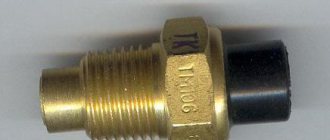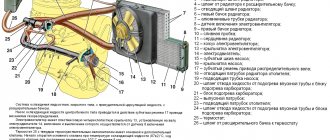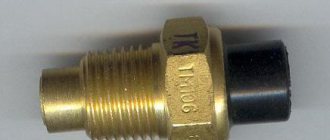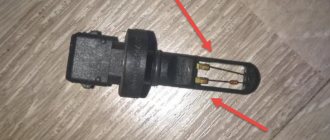Internal combustion engines are far from perfect, so most of the energy consumed during the operation of such units is released in the form of heat. In the winter season, this “by-product” can be successfully used to maintain optimal air temperature in the cabin, but in the summer this is not necessary, so antifreeze can boil even after a short period of operation of the internal combustion engine. When the coolant heats up to a certain value, the fan automatically turns on and the coolant temperature returns to normal. The VAZ 2110 fan switch-on sensor, with the help of which the forced cooling of the internal combustion engine is timely activated, will be discussed in this article.
Design and principle of operation
The VAZ 2110 fan sensor, both 8 and 16 valves, consists of a sealed housing, inside of which there is a bimetallic plate and electrical contacts. A feature of the working element is the possibility of significant physical expansion when heated. When the temperature changes significantly upward, the plate expands and the thermal relay contacts close.
On the outside of the housing, a thread is cut, which is necessary for reliable fixation of the sensor in the cooling system of the internal combustion engine. On the opposite side of the sensor, terminals are installed that are necessary for connecting the contact wires.
Description of the coolant temperature controller
The temperature sensor is a resistor element that performs the function of transmitting and receiving data about the temperature of the consumable in the cooling system. As the temperature increases, the sensor's resistance changes, causing it to supply voltage to the instrument panel. The latter has an indicator that shows to what temperature the car’s power unit has warmed up. Where is DTOZH located? The device is located on the cylinder head, behind the fourth cylinder.
In injection machines, the DTOZh gives the ECU temperature readings, and the ECU turns on the fan itself, the fan switch on sensor, as a rule, is a power sensor, closes the contacts at a certain temperature - turns on the fan relay and is located mainly on the radiator (in a carburetor car), since the DTOZH is located on the engine.
Principle of operation
The principle of operation of DTOZH is the constant interaction of a magnetic field (constant) with the field of measuring devices. Voltage passes through all windings. The permanent magnet is connected to the indicator located in the dashboard. When the temperature changes, the resistance parameter of the device also changes, which leads to the oscillation of the needle.
Possible problems and methods for eliminating them
What malfunctions can occur in the operation of the device:
- The sensor has failed. This problem can be solved by replacing the controller with a functional one.
- The contact on the connector connecting the device to the on-board network is damaged. Also, the contacts may be oxidized. In case of such a malfunction, you can try to clean the contacts, but if their damage is very severe, then it is better to replace the connector.
- The device may stop working due to a damaged electrical circuit. It is necessary to diagnose the condition of the wiring with a tester; if the circuit is truly damaged, then the faulty section must be repaired or replaced.
Regulator diagnostics
To check functionality, you need to perform the following steps:
- First you need to warm up the power unit so that the temperature of the internal combustion engine increases to 90 degrees. After this, the engine can be turned off.
- Next, the ignition is activated and the car's capo opens.
- You need to disconnect the tip of the wire with the measuring device, and then short it to the motor housing.
- If, as a result of the actions performed, the sensor arrow on the control panel began to deviate to the right, entering the red zone, this indicates a breakdown of the controller. If the arrow does not move, then most likely there is an open circuit in the connection circuit.
The easiest way to check for an open circuit: on a working engine, remove the chip from the DTOZH, if everything is normal and there is no break in any circuit, then the fan will turn on at maximum speed (video shot by Dmitry Makarov).
Symptoms of a problem
If the engine boils, and the characteristic hum of the cooling system fan is not heard, then with a high degree of probability one can suspect the presence of a malfunction of the internal combustion engine. The opposite situation, when forced cooling operates as long as the ignition is on, will also indicate a problem with the automation. On a VAZ 2110 injector, a constantly switched on fan sensor may indicate problems with the controller. The control unit could “remember” an error that appeared earlier and, as a result, the electric motor is activated every time it is started.
Periodic turning on and off of the fan when the engine is not yet warmed up is also a sure sign of an imminent failure of the combustion engine.
Causes and symptoms of sensor failure
Typically, such a sensor is a bimetallic thermal switch that operates at certain temperatures. Since its working area is in constant contact with an aggressive liquid (antifreeze), oxidation of the contacts occurs and, as a result, the sensor fails. If you experience the following symptoms, then you urgently need to contact a car service:
- The fan does not turn on
- The fan turns on but runs unevenly
- The fan turns on when the temperature is too low or high
- The fan runs constantly
The design of many foreign cars involves a constant supply of voltage to the fan. In this case, the sensor simply interrupts the circuit, that is, turns off the fan when necessary. In other cars, it’s the other way around – the sensor closes the circuit, thereby turning on the fan. As a result, a malfunction of the sensor can lead to the cooling fan running constantly, thereby preventing the engine from reaching operating temperature, or, conversely, not turning on at all, which can lead to engine overheating.
Where is
Drivers who have never encountered a malfunction in forced engine cooling before may not know where the internal combustion engine is located. On a carburetor VAZ 2110, this element of the cooling system is located on the radiator. If the driver finds this part, then he can easily find the fan switch sensor, which is located on the side. A characteristic feature of the product is the electrical wires connected to it. On the injection VAZ 2110, this part can be found on the cylinder block.
The sensor located in this way allows you to respond promptly to changes in coolant temperature. In addition, access to this part is not difficult and you can immediately begin repair or diagnostic measures if there are doubts about its performance.
Description of the fan switch sensor
Where is the injector or carburetor in the VAZ 2107, what is its purpose? To begin with, we recommend that you familiarize yourself with the purpose and possible malfunctions.
Location and purpose
This controller is an integral element of the cooling system of the power unit and actually performs a function similar to a thermostat. When the engine temperature increases to a certain value, the controller activates the ventilation device, which helps cool the engine radiator. A ventilation device is used to remove heat from the radiator by forcing an air flow onto it. The main purpose of the fan sensor is to prevent overheating of the power unit.
As for the installation location, you should look for this device in the engine compartment of the VAZ 2107. Opening the hood, you can immediately see the radiator assembly, where the sensor is installed. Depending on the shape of the radiator device, the controller can be located at the bottom left or right.
Operating principle
The operating principle is as follows:
- On the bottom of the controller there is a special plate that changes, that is, bends if the temperature of the power unit increases.
- During bending, the plate exerts a certain pressure on the piston. The latter begins to move forward, while moving it closes the contacts on the device. We are talking about both moving and fixed contacts.
- If the coolant remains cold and does not heat up, the plate, accordingly, will not bend.
Forced fan activation
In accordance with the technical characteristics of the Semerka cooling system, the fan should not run constantly. But in some cases, the principle of its forced inclusion is still implemented. This occurs as a result of a controller failure - the temperature sensor located in the engine compartment has displayed data on the instrument panel about an overheated power unit, but the fan does not turn on. This may indicate a breakdown of the fan sensor or poor contact with the vehicle's on-board network.
How to replace
The fastest and easiest way to find out the reason for the fan not turning on or running continuously is to replace the DVV with a known good product. To avoid further confusion, it is not recommended to use used products, as well as sensors purchased from unverified retail outlets.
To carry out work on replacing the internal combustion engine, it is necessary to prepare a new part, a set of wrenches, rags and a container for collecting coolant. The process of removing the old part and installing a new sensor is as follows:
- Place the car on a level surface.
- Disconnect the negative terminal of the battery.
- Unscrew the cap of the expansion tank.
- Disconnect the wires from the DVV.
- Place a wide container under the engine to collect coolant.
- Using a 30mm wrench, unscrew the faulty part.
- Install a new DVV.
- Connect wires to the sensor.
- Pour coolant into the expansion tank.
- Close the lid.
- Connect the battery.
After starting the engine, it must be allowed to run for 15–20 minutes. During this time, the coolant temperature will reach a level at which the thermal relay contacts close and the fan will begin to rotate.
Diagnosis and common causes of cooling system problems
Closing contacts
One of the most common causes of this breakdown is a banal short circuit of the contacts of the coolant temperature sensor. In this case, when the ignition is turned on, the cooling fan turns on, since electric current is constantly supplied to the fan due to a short circuit. The consequence of such a malfunction may be, perhaps, accelerated discharge of the car battery.
We recommend reading an article on the topic: how to extend the life of a car battery. This article talks about the reasons for the short life of the battery, how to actually extend it, as well as the main signs of battery failure.
To diagnose this malfunction, you should disconnect the sensor and use an ohmmeter to measure the resistance at its contacts. If the sensor is working normally, then the resistance will be extremely high (the readings are only nines, which is analogous to “infinite” resistance). If the resistance is low, then the contacts are closed and the sensor must be replaced.
Also similar symptoms include a short circuit of the fan terminals to ground, in which case it will also work constantly as soon as the ignition is turned on. Since the voltage is supplied directly from the battery.
Small amount of antifreeze
Another common problem is too little coolant. It is to its temperature that the DTOZH reacts. With a small amount of antifreeze, the liquid warms up much faster than the engine itself warms up, as a result the fan turns on too early. Add fluid to the required level and, just in case, check for leaks in the cooling system.
Thermostat and its sensors
On some modern cars, the cooling system is equipped with thermostats with sensors that regulate the operation of the cooling system more efficiently. However, this design is more complex in structure than a conventional one, and due to its complexity it is susceptible to various problems. If the operation of a specific sensor that is connected to the thermostat is disrupted. Or the cooling control system does not receive data from the thermostat sensors, then, as a rule, it “goes into protection”, turning on the fan for constant operation. Checking these sensors is, in principle, similar to checking the contacts of a conventional DTOZH. We measure the resistance, and if it is low, then the sensor should be changed.
It is worth noting that the ECU can also “go into protection” in cases where the fan is controlled through the on-board computer itself. The reason for this may be problems with contacts. As a rule, contacts tend to oxidize over time, which greatly complicates the transmission of signals from sensors to the ECU. And if the required signal does not pass through at all, then in this case the control unit forcibly turns on the cooling fan, regardless of the engine temperature.
To eliminate it, you just need to clean the contacts and coat them with insulating grease to prevent the spread of corrosion. By the way, this procedure is recommended to be carried out 2 times a year to avoid unpleasant situations at the most inopportune moment.
Diagnostics of VDV
If, as a result of replacing the sensor, the functionality of the cooling system is not restored, then the new part may be defective.
To make sure that the DVV is working, you need to perform the following simple steps:
- Remove the sensor from the car.
- Place it in a metal container with water.
- Place the tank on the gas stove.
- Boil.
- Remove the DVV from the container and measure the resistance between the contacts.
You can use an inexpensive multimeter or tester to perform the diagnostic operation. If, as a result of measurements, the presence of insignificant electrical resistance is established, then the sensor is in working order and can be used for its intended purpose. How to check this part is now clear, so if you don’t find an inexpensive used part, you can also install it after a diagnostic operation.
Checking the functionality of the sensor
Checking the functionality of the device should begin with monitoring the response temperature. To do this you will need a thermometer and a multimeter. All actions can be performed independently, without resorting to a visit to the service center. If the multimeter is equipped with a thermocouple, then there is no need for a thermometer. To check the sensor, follow the instructions below:
- Switch the multimeter to resistance measurement mode. For convenience, you can select the dialing mode;
- Immerse the threaded part of the sensor in water;
- Start gradually heating the water. You can control the temperature using a thermometer, or temporarily switching the multimeter to the thermocouple mode;
- Wait for the device to respond;
The multimeter shows the sensor response - Compare the temperature to which the sensor responded with the nominal value.
If there is a critical deviation of the response limit, the sensor must be replaced. After purchasing a new device, you must check its suitability. Defective products are very common on sale, so checking whether the sensor turns on correctly is the responsibility of every car owner.
New device purchased as a replacement
Tips and tricks
During the diagnostic operations and replacement procedure, some difficulties may arise that you should be aware of in advance, for example:
- The sensor may be fully operational and the wiring intact, but the fuse installed in this electrical circuit may fail. It is also recommended to replace this part with a new one in order to exclude it from the list of possible “culprits” for the fact that the VAZ 2110 fan does not turn on.
- You can diagnose the fan switch sensor without a multimeter or tester. It is enough to assemble an elementary circuit with a current source, a light bulb and a series-connected DVR, which will serve as a thermal switch.
The process of replacing the DVV VAZ 2110 is simple, so even if you have no experience in performing such work, you can perfectly perform this operation the first time without outside help.
Instructions for replacing the TOZh sensor with your own hands
Replacing the DTOZH is carried out as follows:
- First you need to turn off the ignition and open the hood of your car.
- Next, you need to place a container under the drain hole of the engine radiator; all the coolant will collect in it. Open the plug and drain the antifreeze, then find the DTOZH and disconnect the connector from it.
- Using a wrench, you will need to dismantle the controller. The device is removed from its installation location. When removing you can see the rubberized seal, when you remove the regulator, do not lose it. If you notice that the rubber band is very worn, it will need to be replaced.
- After this, you will need to install the new controller in the installation location. Using a wrench, screw the device all the way, and then connect the connector with the wire that you disconnected when dismantling. Now all you have to do is pour the working fluid into the radiator device and turn on the ignition, start the engine and check the operation of the device.
Modernization
If you want to improve the operation of your radiator fan on the VAZ 2109, we offer the appropriate instructions.
To upgrade, you will need to install a second sensor and modify the system somewhat.
- The standard power sensor will be responsible for the operation of the fan at maximum speed.
- An additional sensor will include a reduced speed. It is installed at the top of the cooling system.
Now let’s talk more specifically about how to organize all this.
- Take a temperature sensor whose response temperature is similar to the standard regulator.
- Install it in the upper pipe fitting to the radiator.
- To mount the element, you will need a pair of washers and a nut. Be sure to lubricate the washer with sealant to prevent leakage from the installation hole.
- Buy a resistor to install on the stove fan. It has several outputs, so if desired, you can make several operating speeds.
- It is necessary to make an additional control circuit. Through it, less voltage will be supplied to the motor winding.
- The temperature sensor located in the upper part of the cooling system is responsible for turning it on.
- It is better to do control not by plus, but by weight.
- The system will work through a button in the cabin. To the left of the dashboard there is a grille with two plugs. Cut out one of them and set it to turn off on two modes. You can take the heater switch from a VAZ 2107.
- In the first position the low frequency will be switched on, and in the second – the maximum speed.
- One common wire is fed to the minus.
Such modernization is not provided for by the design of the VAZ 2109. These are modifications made by car enthusiasts. Therefore, installing a second sensor is entirely your personal responsibility.
The fan is an important component of the cooling system of VAZ 2109 injection and carburetor engines. If you wish and have time, you can easily replace or repair it yourself.
How to check the cooling fan on a VAZ 2114?
There are several ways to check whether the fan is working on a VAZ 2114. First, it’s worth determining whether the main structural element – the electric motor – is working. Due to the convenient location of the motor, you can easily get to its contacts. If you have wires, you can connect the motor directly to the battery. If the motor starts working, the cause of the breakdown is clearly not in it.
In the photo above, the chip with the wire is clearly visible. This chip has a plug. The test should be done by connecting two wires directly to the battery. Often the cause of malfunction and failure of the electric motor is the temperature sensor. The host computer protection system in 2114 is such that when this sensor is turned off, the fan must operate in emergency mode. It is enough to warm up the car to operating temperature, and then turn off the sensor. At this moment, the controller determines the absence of a sensor as a malfunction and turns on the fan in emergency mode. This element can be changed without any problems. Having removed the chip from the sensor connector, do not forget to put it back in place after checking the functionality of the blower.
A little theory
| Characteristic | Explanation |
| Location | The sensor is located in the heater radiator. It is not difficult to determine that this is the one in front of you, since in the radiator it is the only element to which the wires are connected. And if you take a 30 key, then only the sensor has the appropriate fastener size. |
| Response temperature | Sensors may have different temperature limits. But for the VAZ 2114, switching on occurs at 102-105 degrees Celsius, and switching off occurs at 85-87 degrees. When choosing a new meter, focus on the one that has failed, or purchase one with an on and off indicator of 102 and 87 degrees, respectively |
| Operating principle | There is a special contact group inside the sensor. When the coolant in the radiator heats up, this group heats up and expands. When the expansion reaches a certain limit, the contacts close, they transmit a signal to the wiring and the fan turns on |
Safety valve
Knowing physics, you will agree that at normal atmospheric pressure, the water that is part of antifreeze boils at a temperature of 100 degrees Celsius.
To fix this problem, replace the expansion tank cap. The new element must maintain the pressure inside the system above atmospheric pressure, which will allow the laws of physics to work, the boiling temperature to rise to 105 degrees Celsius and thereby turn on the blades of the unit.











